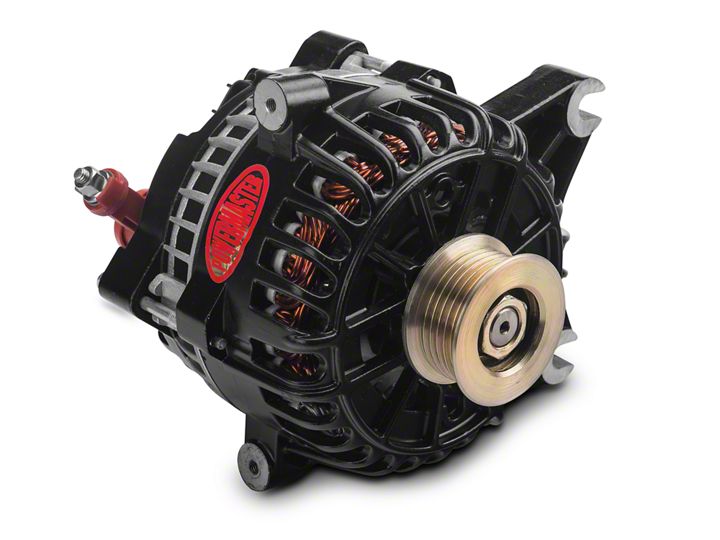
How to Install Powermaster Alternator - 200 Amp on your F-150

Shop Parts in this Guide
PLEASE KEEP IN MIND...
• ALWAYS wear eye protection when working around batteries.
• ALWAYS disconnect battery ground terminal and cable assembly before replacing electrical components.
• NEVER disconnect a battery cable or alternator cable and wires when engine is running. Transient voltages (spikes) are produced when this occurs and some of these voltages exceed 200 volts. This can cause alternator voltage regulator or engine computer failure.
• AVOID short circuits. When working with live circuits, never jumper between terminals or from terminals to ground, nor try to trouble shoot by "sparking" terminals. Always use a quality voltmeter to check the operation of live circuits.
• CHECK the battery. Alternators and batteries work together. It is important that the battery be in good condition and fully charged when replacing the alternator. Do use an alternator to charge a dead battery.

INSTALLATION
These instructions are provided as supplementary information to the factory service manual instructions for alternator replacement.
DISCONNECT THE BATTERY.
REMOVE THE OLD ALTERNATOR. See the factory service manual for more details. Remove the belt noting its routing and then remove the alternator. Be sure to label all wires before removing to assure proper reinstallation and location.
INSTALL THE NEW ALTERNATOR.
♦ If the belt system on the vehicle is not compatible with the Powermaster alternator, change pulleys per the instructions on the reverse side of this form. For optimum performance use the pulley that is installed on the Powermaster. In many cases the OE
pulley can be reused on the Powermaster alternator if necessary.
♦ Mount the alternator and check for interference with the brackets or other engine components. Tighten all the bolts.
♦ Check for proper belt alignment. Proper alignment is critical for serpentine belts. In cases where the supplied alternator pulley has more grooves than necessary, seat the belt as close as possible to the alternator.
♦ Install the belt per the factory service manual instructions.
♦ Reconnect all wires and check labeling for correct location. If the Powermaster alternator is of a higher amperage that the alternator that came OE on the vehicle then Powermaster recommends upgrading the battery output cable from the alternator. Your
local speed shop has optional charge wires for this purpose.
CONNECT THE BATTERY.

SYSTEM CHECK
♦ Apply a moderate load to the charging system (i.e., high beam headlights and A/C for example) and bring the engine to 1,500rpm. Using a digital voltmeter measure the DC voltage from the a bare metal point on the case of the alternator to the negative battery terminal. Readings higher than 0.10VDC indicate a poor ground connection. Check the ground path including any paint or anodizing on the brackets, the engine ground strap, and the ground cable from the frame to the battery. (See figure 1).


♦ With battery fully charged and engine running at 1,500rpm, measure the voltage at battery positive post ( ) and the ground post (-). Voltage should be 13.8~14.5VDC. Readings above 15.5VDC indicate a defective alternator and readings below 12.7VDC indicate that the alternator is not functioning or cannot supply the current amperage needs of the vehicle at this engine speed.
♦ Using the voltmeter, measure the voltage drop between the batty positive post ( ) and the alternator output post (See figure 2). Voltage should be less that 0.40VDC. If voltage is higher that 0.40VDC, check for poor connections between the alternator and the battery. Possible causes are undersized battery cables, loose or improperly crimped terminals, and corroded connections.
Need to change a pulley?
To remove the alternator pulley, use an air impact wrench to loosen the nut with one hand, while holding the alternator pulley with the other. It is recommended that protective gloves and eyewear be used. If an air impact wrench is not available, a 5/16” hex bit socket and ratchet can be used to hold the alternator shaft, while a typical 15/16” boxed-end wrench can be used to loosen the nut. The pulley nut uses standard, right-hand threads. So to remove, rotate in a counter-clockwise direction. Install the V-belt pulley, lock washer, and nut by hand. Torque the pulley nut to 70 ft. lbs. and be certain the lock washer is completely closed. Do not over tighten.
Why is my voltage low when I’m cruising around at a show or sitting at a traffic light?
All alternators have an output curve that increases with RPMs. In other words, your alternator cannot provide as many amps at idle as it can at higher speeds. If you car demands more amperage than the alternator can supply at idle, the remaining amps must come from the battery thus a decrease in voltage results. Any after market pulleys that slow the alternator relative to the engine [i.e. power pulleys] can greatly magnify this problem.
Why does my voltage test good at the alternator but low at the battery and fuse box?
Any resistance in the electrical path will decrease voltage. This includes all positive and negative conductors and connections between the alternator and the second test point. All connections must be secure and free of corrosion. All ground points must be free of paint and rust. Charging wires must be of adequate size for the amperage capabilities of your alternator. Improving any weak points in the electrical paths should bring voltage readings to within 0.5 volts of each other.

